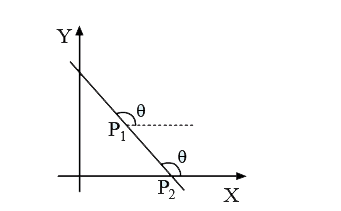A slip of paper is given to a person A who marks it either with a plus sign or a minus sign. The probability of his writing a plus sign is 1/3. A passes the slip to B, who may either leave it alone or change the sign before passing it to C. Next C passes the slip to D after perhaps changing the sign. Finally D passes it to a refere after perhaps changing the sign. B,C,Deachchan≥thesignwithprobability2//3.
If the refree observes a plus sign on the slip then the probability that A originally wrote a plus sign is
13/41
19/27
17/25
21/37
The correct Answer is:A
To solve the problem step by step, we will use the concept of conditional probability and Bayes' theorem.
Step 1: Define the Events
Let:
- A+: Event that A writes a plus sign.
- A−: Event that A writes a minus sign.
- R+: Event that the referee observes a plus sign.
Given:
- P(A+)=13
- P(A−)=23
Step 2: Calculate the Probability of Referee Observing a Plus Sign Given A's Sign
We need to calculate P(R+|A+) and P(R+|A−).
Case 1: A writes a plus sign (A+)
If A writes a plus sign, the probabilities for B, C, and D changing the sign are:
- Each of B, C, D changes the sign with probability 23 and does not change it with probability 13.
The possible scenarios for R+ given A+:
1. None of B, C, D change the sign:
P(B−,C−,D−)=(13)3=127
2. Exactly one of B, C, D changes the sign:
- Choose 1 from 3 to change (3 ways), and the others do not change:
P(B+,C−,D−)+P(B−,C+,D−)+P(B−,C−,D+)=3⋅(23)(13)2=3⋅227=627
3. Exactly two of B, C, D change the sign:
- Choose 2 from 3 to change (3 ways), and the other does not change:
P(B+,C+,D−)+P(B+,C−,D+)+P(B−,C+,D+)=3⋅(23)2(13)=3⋅427=1227
4. All three change the sign:
P(B+,C+,D+)=(23)3=827
Adding these probabilities gives:
P(R+|A+)=127+627+1227+827=2727=1
Case 2: A writes a minus sign (A−)
If A writes a minus sign, we analyze similarly:
1. None of B, C, D change the sign:
P(B−,C−,D−)=(23)3=827
2. Exactly one of B, C, D changes the sign:
3⋅(23)2(13)=3⋅427=1227
3. Exactly two of B, C, D change the sign:
3⋅(23)(13)2=3⋅227=627
4. All three change the sign:
P(B+,C+,D+)=(13)3=127
Adding these probabilities gives:
P(R+|A−)=827+1227+627+127=2727=1
Step 3: Apply Bayes' Theorem
Now we apply Bayes' theorem to find P(A+|R+):
P(A+|R+)=P(R+|A+)P(A+)P(R+|A+)P(A+)+P(R+|A−)P(A−)
Substituting the values:
P(A+|R+)=1⋅131⋅13+1⋅23=1313+23=131=13
Final Answer
Thus, the probability that A originally wrote a plus sign given that the referee observes a plus sign is:
13
Let:
- A+: Event that A writes a plus sign.
- A−: Event that A writes a minus sign.
- R+: Event that the referee observes a plus sign.
- P(A+)=13
- P(A−)=23
We need to calculate P(R+|A+) and P(R+|A−).
If A writes a plus sign, the probabilities for B, C, and D changing the sign are:
- Each of B, C, D changes the sign with probability 23 and does not change it with probability 13.
1. None of B, C, D change the sign:
P(B−,C−,D−)=(13)3=127
2. Exactly one of B, C, D changes the sign:
- Choose 1 from 3 to change (3 ways), and the others do not change:
P(B+,C−,D−)+P(B−,C+,D−)+P(B−,C−,D+)=3⋅(23)(13)2=3⋅227=627
3. Exactly two of B, C, D change the sign:
- Choose 2 from 3 to change (3 ways), and the other does not change:
P(B+,C+,D−)+P(B+,C−,D+)+P(B−,C+,D+)=3⋅(23)2(13)=3⋅427=1227
4. All three change the sign:
P(B+,C+,D+)=(23)3=827
P(R+|A+)=127+627+1227+827=2727=1
If A writes a minus sign, we analyze similarly:
1. None of B, C, D change the sign:
P(B−,C−,D−)=(23)3=827
2. Exactly one of B, C, D changes the sign:
3⋅(23)2(13)=3⋅427=1227
3. Exactly two of B, C, D change the sign:
3⋅(23)(13)2=3⋅227=627
4. All three change the sign:
P(B+,C+,D+)=(13)3=127
P(R+|A−)=827+1227+627+127=2727=1
Now we apply Bayes' theorem to find P(A+|R+):
P(A+|R+)=P(R+|A+)P(A+)P(R+|A+)P(A+)+P(R+|A−)P(A−)
Substituting the values:
P(A+|R+)=1⋅131⋅13+1⋅23=1313+23=131=13
Thus, the probability that A originally wrote a plus sign given that the referee observes a plus sign is:
13
Topper's Solved these Questions
- PROBABILITYBOOK - CENGAGE ENGLISHCHAPTER - PROBABILITYEXERCISE - Multiple Correct Answer
13 Videos
- PRINCIPLE OF MATHEMATICAL INDUCTIONBOOK - CENGAGE ENGLISHCHAPTER - PRINCIPLE OF MATHEMATICAL INDUCTIONEXERCISE - Sovled Examples
22 Videos
- PROBABILITY I BOOK - CENGAGE ENGLISHCHAPTER - PROBABILITY I EXERCISE - JEE Advanced
7 Videos
Similar Questions
A slip of paper is given to a person A who marks it either with a plus sign or a minus sign. The probability of his writing a plus sign is 1/3. A passes the slip to B, who may either leave it alone or change the sign before passing it to C. Next C passes the slip to D after perhaps changing the sign. Finally D passes it to a refere after perhaps changing the sign. B,C,Deachchan≥thesignwithprobability2//3.<br>TheprobabilitytˆtherefereeobservesaplussignontheslipifitisknowntˆA wrote a plus sign is
View SolutionMontreal protocol was signed in
View SolutionFind the sign of the : tan2500∘
View Solutionin an atomic orbital the sign of lobes indicate the
View SolutionFind the sign of the slope and its nature.

View SolutionMost of female bufflaoes show sign of heat in the
View SolutionDefine heat and work and mention their sign conventions.
View SolutionWhat is the sign convention for heat ?
View SolutionIn the questions , if the charges with the same sign are interchanged then the work doen is
View SolutionNumber of ways in which 5 plus (+) signs and 5 minus (-) signs be arranged in a row so that no two minus signs are together is
View Solution
